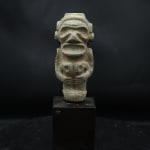Taino Stone Zemi Sculpture, 1200 CE - 1500 CE
Stone
12 x 5 cm
4 3/4 x 2 in
Dimensions given without mounting
4 3/4 x 2 in
Dimensions given without mounting
LR.025
Further images
-
(View a larger image of thumbnail 1
)

-
(View a larger image of thumbnail 2
)

-
(View a larger image of thumbnail 3
)

-
(View a larger image of thumbnail 4
)

-
(View a larger image of thumbnail 5
)

-
(View a larger image of thumbnail 6
)

-
(View a larger image of thumbnail 7
)

-
(View a larger image of thumbnail 8
)

-
(View a larger image of thumbnail 9
)

This intriguing stone sculpture is a zemi – the physical incarnation of a Taino god, spirit or ancestor. These were used by families and centralized magico-religious institutions on a village...
This intriguing stone sculpture is a zemi – the physical incarnation of a Taino god, spirit or ancestor. These were used by families and centralized magico-religious institutions on a village scale, in order to “…help women with child…many which speak, and others that make grow the things that they eat, and others that bring rain, and others that make the wind blow” (Arrom 1974: 26). Historical accounts by Columbus, among others, also confirm a fertility role for at least some of the pieces. Identifying specific pieces with specific gods or spirits is not always possible; the pantheon of gods is fairly well established (based around Yucahu – the god of cassava, the Taino staple crop – and his mother Antabey, who is responsible for fertility and water) but their physical appearances are generally undefined. Zemis have been found in various parts of the Caribbean, especially Hispaniola and Jamaica.








